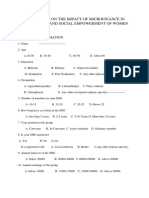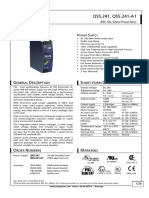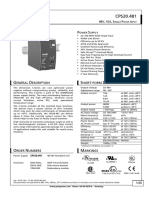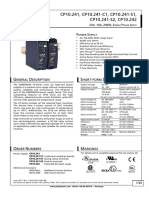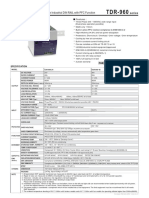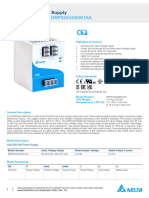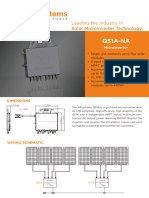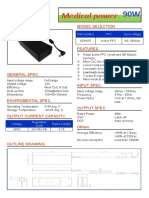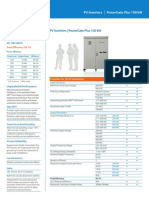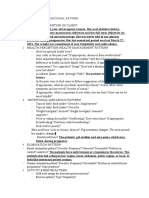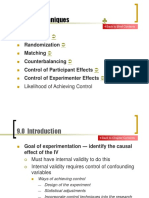qs40 241
qs40 241
Uploaded by
sunil_dharCopyright:
Available Formats
qs40 241
qs40 241
Uploaded by
sunil_dharOriginal Title
Copyright
Available Formats
Share this document
Did you find this document useful?
Is this content inappropriate?
Copyright:
Available Formats
qs40 241
qs40 241
Uploaded by
sunil_dharCopyright:
Available Formats
QS40.
241
Q-Series 24V, 40A, SINGLE PHASE INPUT
POWER SUPPLY
AC 100-240V Wide-range Input
Width only 125mm, Weight only 1.9kg
94.6% Full Load and Excellent Partial Load Efficiencies
50% BonusPower®, 1440W for up to 4s
110A High Peak Current for 10ms for Easy Fuse Tripping
Safe HiccupPLUS Overload Mode
Active PFC (Power Factor Correction)
Negligible Low Input Inrush Current Surge
Full Power Between -25°C and +60°C
Current Sharing Feature for Parallel Use
Internal Data Logging for Troubleshooting Included.
Remote Control of Output Voltage
DC-OK Relay Contact
Shut-down Input
ATEX and IECEx Approved
3 Year Warranty
GENERAL DESCRIPTION SHORT-FORM DATA
The most outstanding features of this Dimension Output voltage DC 24V nominal
QS40.241 DIN-rail power supply are the extremely high Adjustment range 24 - 28Vdc
efficiency and the small size, which are achieved by a Output current 40 – 34.3A continuous
synchronous rectification, a bridgeless PFC circuit and
60 – 51.5A short term (4s)
additional unique design details.
Output power 960W continuous
Large power reserves of 150% and built-in large sized
1440W short term (4s)
output capacitors support the starting of heavy loads
Output ripple < 100mVpp 20Hz to 20MHz
such as DC motors or capacitive loads. In many cases this
allows the use of a unit from a lower wattage class Input voltage AC 100-240V -15%/+10%
which saves space and money. Mains frequency 50-60Hz ±6%
High immunity to transients and power surges as well as AC Input current 8.6 / 4.5A at 120 / 230Vac
low electromagnetic emissions makes usage in nearly Power factor 0.99 / 0.99 at 120 / 230Vac
every environment possible. AC Inrush current 17 / 11A peak at 120 / 230Vac
The integrated input fuse as well as the near zero input Efficiency 93.6 / 94.6% at 120 / 230Vac
inrush current make installation and usage simple. Losses 65.6 / 54.8W at 120 / 230Vac
Diagnostics are easy due to the DC-OK relay, a green Temperature range -25°C to +70°C operational
DC-OK LED and the red overload LED. Derating 24W/°C +60 to +70°C
A large international approval package for a variety of between 85-90Vac see chapter 18
applications makes this unit suitable for nearly every Hold-up time 27 / 27ms at 120 / 230Vac
application. Dimensions 125x124x127mm WxHxD
Weight 1900g / 4.2lb
ORDER NUMBERS MARKINGS
Power Supply QS40.241 24-28V Standard unit
IND. CONT. EQ.
UL 60950-1 EMC, LVD, RoHS
Accessory ZM2.WALL Wall mount bracket UL 508
UF20.241 Buffer unit
YR80.242 Redundancy module IECEx ATEX
Class I Div 2 II 3G Ex nA nC II T4 Gc
Oct. 2014 / Rev. 1.2 DS-QS40.241-EN
All parameters are specified at 24V, 40A, 230Vac, 25°C ambient and after a 5 minutes run-in time unless otherwise noted. 1/28
www.pulspower.com Phone +49 89 9278 0 Germany
QS40.241
Q-Series 24V, 40A, SINGLE PHASE INPUT
INDEX
Page Page
1. Intended Use .......................................................3 23. Physical Dimensions and Weight ..................... 19
2. Installation Requirements...................................3 24. Accessories ........................................................ 20
3. AC-Input...............................................................4 24.1. ZM2.WALL - Wall mounting bracket .......20
4. Input Inrush Current ...........................................5 24.2. UF20.241 - Buffer module ........................20
5. DC-Input...............................................................5 24.3. YR80.242 - Redundancy Module..............21
6. Output .................................................................6 24.4. YR40.245 - Redundancy Module..............21
7. Hold-up Time.......................................................8 25. Application Notes............................................. 22
8. DC-OK Relay Contact ..........................................9 25.1. Repetitive Pulse Loading..........................22
9. Shut-down Input .................................................9 25.2. Peak Current Capability ...........................23
10. Remote Control of Output Voltage .................10 25.3. External Input Protection.........................23
11. Internal Data Logging.......................................10 25.4. Charging of Batteries ...............................24
12. Efficiency and Power Losses..............................11 25.5. Output Circuit Breakers............................24
13. Lifetime Expectancy and MTBF.........................12 25.6. Parallel Use to Increase Output Power....25
14. Functional Diagram...........................................12 25.7. Parallel Use for Redundancy ....................25
15. Terminals and Wiring........................................13 25.8. Series Operation .......................................26
16. Front Side and User Elements...........................14 25.9. Inductive and Capacitive Loads................26
17. EMC....................................................................15 25.10. Back-feeding Loads ..................................26
18. Environment ......................................................16 25.11. Operation on Two Phases ........................27
19. Protection Features ...........................................17 25.12. Use in a Tightly Sealed Enclosure ............27
20. Safety Features ..................................................17 25.13. Mounting Orientations ............................28
21. Dielectric Strength ............................................18
22. Approvals...........................................................18
The information presented in this document is believed to be accurate and reliable and may change without notice.
No part of this document may be reproduced or utilized in any form without permission in writing from the publisher.
TERMINOLOGY AND ABREVIATIONS
PE and symbol PE is the abbreviation for Protective Earth and has the same meaning as the symbol .
Earth, Ground This document uses the term “earth” which is the same as the U.S. term “ground”.
T.b.d. To be defined, value or description will follow later.
AC 230V A figure displayed with the AC or DC before the value represents a nominal voltage with
standard tolerances (usually ±15%) included.
E.g.: DC 12V describes a 12V battery disregarding whether it is full (13.7V) or flat (10V)
230Vac A figure with the unit (Vac) at the end is a momentary figure without any additional
tolerances included.
50Hz vs. 60Hz As long as not otherwise stated, AC 230V parameters are valid at 50Hz mains frequency.
may A key word indicating flexibility of choice with no implied preference.
shall A key word indicating a mandatory requirement.
should A key word indicating flexibility of choice with a strongly preferred implementation.
Oct. 2014 / Rev. 1.2 DS-QS40.241-EN
All parameters are specified at 24V, 40A, 230Vac, 25°C ambient and after a 5 minutes run-in time unless otherwise noted. 2/28
www.pulspower.com Phone +49 89 9278 0 Germany
QS40.241
Q-Series 24V, 40A, SINGLE PHASE INPUT
1. INTENDED USE
This device is designed for installation in an enclosure and is intended for the general use such as in industrial control,
office, communication, and instrumentation equipment.
Do not use this power supply in equipment, where malfunction may cause severe personal injury or threaten human
life.
This device is designed for use in hazardous, non-hazardous, ordinary or unclassified locations.
2. INSTALLATION REQUIREMENTS
This device may only be installed and put into operation by qualified personnel.
This device does not contain serviceable parts. The tripping of an internal fuse is caused by an internal defect.
If damage or malfunction should occur during installation or operation, immediately turn power off and send unit to
the factory for inspection.
Mount the unit on a DIN-rail so that the output and input terminals are located on the bottom of the unit. For other
mounting orientations see de-rating requirements in this document. See chapter 25.13.
This device is designed for convection cooling and does not require an external fan. Do not obstruct airflow and do
not cover ventilation grid (e.g. cable conduits) by more than 15%!
Keep the following installation clearances: 40mm on top, 20mm on the bottom, 5mm on the left and right sides are
recommended when the device is loaded permanently with more than 50% of the rated power. Increase this clearance
to 15mm in case the adjacent device is a heat source (e.g. another power supply).
A disconnecting means shall be provided for the output of the power supplies when used in applications according to
CSA C22.2 No 107.1-01.
WARNING Risk of electrical shock, fire, personal injury or death.
- Do not use the power supply without proper grounding (Protective Earth). Use the terminal on the input block for
earth connection and not one of the screws on the housing.
- Turn power off before working on the device. Protect against inadvertent re-powering.
- Make sure that the wiring is correct by following all local and national codes.
- Do not modify or repair the unit.
- Do not open the unit as high voltages are present inside.
- Use caution to prevent any foreign objects from entering the housing.
- Do not use in wet locations or in areas where moisture or condensation can be expected.
- Do not touch during power-on, and immediately after power-off. Hot surfaces may cause burns.
Notes for use in hazardous location areas:
The power supply is suitable for use in Class I Division 2 Groups A, B, C, D locations and for use in Group II Category 3
(Zone 2) environments and are evaluated according to EN 60079-0:2012 and EN 60079-15:2010.
WARNING EXPLOSION HAZARDS!
Substitution of components may impair suitability for this environment. Do not disconnect the unit or operate the
voltage adjustment or S/P jumper unless power has been switched off or the area is known to be non-hazardous.
A suitable enclosure must be provided for the end product which has a minimum protection of IP54 and fulfils the
requirements of the EN 60079-15:2010.
Oct. 2014 / Rev. 1.2 DS-QS40.241-EN
All parameters are specified at 24V, 40A, 230Vac, 25°C ambient and after a 5 minutes run-in time unless otherwise noted. 3/28
www.pulspower.com Phone +49 89 9278 0 Germany
QS40.241
Q-Series 24V, 40A, SINGLE PHASE INPUT
3. AC-INPUT
AC input nom. AC 100-240Vsuitable for TN, TT and IT mains networks
AC input range min. 90-264Vac continuous operation
min. 85-90Vac < 55°C ambient temperature continuously allowed
> 55°C ambient temperature short term or with output
derating according Fig. 18-1
min. 60-85Vac full power for up to 200ms
min. 0-85Vac no damage to the unit
min. 264-300Vac < 500ms
Allowed voltage L or N to earth max. 300Vac continuous, IEC 62103
Input frequency nom. 50–60Hz ±6%
Turn-on voltage typ. 80Vac steady-state value, load independent, see Fig. 3-1
Shut-down voltage typ. 74Vac steady-state value, load independent, see Fig. 3-1
External input protection See recommendations in chapter 25.3.
AC 100V AC 120V AC 230V
Input current typ. 10.5A 8.6A 4.5A at 24V, 40A, see Fig. 3-3
Power factor*) typ. 0.99 0.99 0.99 at 24V, 40A, see Fig. 3-4
Crest factor**) typ. 1.47 1.53 1.56 at 24V, 40A
Start-up delay typ. 800ms 750ms 700ms see Fig. 3-2
Rise time typ. 15ms 15ms 15ms at 24V, 40A, resistive load, 0mF
see Fig. 3-2
typ. 18ms 18ms 18ms at 24V, 40A, resistive load,
40mF see Fig. 3-2
Turn-on overshoot max. 100mV 100mV 100mV see Fig. 3-2
*) The power factor is the ratio of the true (or real) power to the apparent power in an AC circuit.
**) The crest factor is the mathematical ratio of the peak value to RMS value of the input current waveform.
Fig. 3-1 Input voltage range Fig. 3-2 Turn-on behavior, definitions
POUT Rated input range Input
Voltage
Shut-down
Turn-on
Output - 5%
Overshoot
Voltage
VIN
Start-up Rise
delay Time
74 80 85 264Vac
Fig. 3-3 Input current vs. output load at 24V Fig. 3-4 Power factor vs. output load at 24V
Input Current, typ. Power Factor, typ.
12A 1.0 A
10 A: 100Vac A
B: 120Vac 0.95 B
8 C: 230Vac B
0.9
6 A: 100Vac
C
0.85 B: 120Vac
4 C: 230Vac
C
2 0.8
Output Current Output Current
0 0.75
4 8 12 16 20 24 28 32 36 40A 4 8 12 16 20 24 28 32 36 40A
Oct. 2014 / Rev. 1.2 DS-QS40.241-EN
All parameters are specified at 24V, 40A, 230Vac, 25°C ambient and after a 5 minutes run-in time unless otherwise noted. 4/28
www.pulspower.com Phone +49 89 9278 0 Germany
QS40.241
Q-Series 24V, 40A, SINGLE PHASE INPUT
4. INPUT INRUSH CURRENT
The power supply is equipped with an active inrush current limitation circuit, which limits the input inrush current
after turn-on to a negligible low value. The input current is usually smaller than the steady state input current.
AC 100V AC 120V AC 230V
Inrush current*) max. 25Apeak 22Apeak 16Apeak over entire temperature range;
mains interruptions > 1s
typ. 20Apeak 17Apeak 11Apeak over entire temperature range;
mains interruptions > 1s
Inrush energy max. 5A2s 5A2s 5A2s over entire temperature range;
mains interruptions > 1s
*) The charging current into EMI suppression capacitors is disregarded in the first microseconds after switch-on.
Fig. 4-1 Typical turn-on behaviour at nominal
load and 25°C ambient temperature
Input Current 5A / DIV
Input
230Vac
24Vdc
Output 100mS/DIV
5. DC-INPUT
Do not operate this power supply with DC-input voltage. Check the CPS20.241-D1 unit instead. Two CPS20.241-D1
units in parallel might be necessary.
Oct. 2014 / Rev. 1.2 DS-QS40.241-EN
All parameters are specified at 24V, 40A, 230Vac, 25°C ambient and after a 5 minutes run-in time unless otherwise noted. 5/28
www.pulspower.com Phone +49 89 9278 0 Germany
QS40.241
Q-Series 24V, 40A, SINGLE PHASE INPUT
6. OUTPUT
Output voltage nom. DC 24V
Adjustment range min. 24-28Vdc guaranteed
max. 29Vdc****) at clockwise end position of potentiometer
Factory setting typ. 24.1Vdc ±0.2%, at full load, cold unit, in “single use” mode
typ. 24.1Vdc ±0.5%, at full load, cold unit, in “parallel use” mode
typ. 25.1Vdc at no load, cold unit, in “parallel use” mode
Line regulation max. 10mV 85-300Vac
Load regulation max. 50mV in “single use” mode: static value, 0AÆ40A, see Fig. 6-1
typ. 1000mV in “parallel use” mode: static value, 0AÆ40A,
see Fig. 6-2
Ripple and noise voltage max. 100mVpp 20Hz to 20MHz, 50Ohm
Output current nom. 40A continuously available at 24V, see Fig. 6-1 and Fig. 6-2
nom. 34.3A continuously available at 28V, see Fig. 6-1 and Fig. 6-2
nom. 60A short term available BonusPower®*), at 24V
for typical 4s, see Fig. 6-1 and Fig. 6-2
nom. 51.5A short term available BonusPower®*), at 28V
for typical 4s, see Fig. 6-1 and Fig. 6-2
typ. 110A up to 10ms, output voltage stays above 20V, see Fig.
6-4, This peak current is available once every second.
See chapter 25.2 for more peak current measurements.
Output power nom. 960W continuously available at 24-28V
nom. 1440W*) short term available BonusPower®*) at 24-28V
BonusPower® time typ. 4s duration until the output voltage dips, see Fig. 6-5
BonusPower® recovery time typ. 7s overload free time to reset power manager, see Fig. 6-6
Overload behavior cont. current output voltage > 20Vdc, see Fig. 6-1
HiccupPLUS mode**) output voltage < 20Vdc, see Fig. 6-1
Short-circuit current min. 60A***) load impedance 25mOhm, see Fig. 6-3
max. 70A***) load impedance 25mOhm, see Fig. 6-3
max. 23A average (R.M.S.) current, load impedance 25mOhm, see
Fig. 6-3
typ. 130A up to 10ms, load impedance <10mOhm, see Fig. 6-4
Output capacitance typ. 10 200μF included in the power supply
*) BonusPower®, short term power capability (up to typ. 4s)
The power supply is designed to support loads with a higher short-term power requirement without damage or shutdown. The short-
term duration is hardware controlled by an output power manager. This BonusPower® is repeatedly available. Detailed information
can be found in chapter 25.1. If the power supply is loaded longer with the BonusPower® than shown in the Bonus-time diagram (see
Fig. 6-5), the max. output power is automatically reduced to 960W. If the power requirement is continuously above 960W and the
voltage falls below approx. 20V (due to the current regulating mode at overload), the unit shuts-off and makes periodical restart
attempts. This behavior is called hiccup mode which is described below. If the voltage is above 20V, the unit continuously delivers
current.
**) HiccupPLUS Mode
Up to 4s of overloading, the power supply delivers continuous output current. After this, the output power is reduced to nearly zero
for approx. 17s before a new start attempt is automatically performed. If the overload has been cleared, the device will operate
normally. If the overload still exists, the output current will be delivered for 2 to 4s (depending on the overload) again followed by a
17s rest time. This cycle is repeated as long as the overload exists. See Fig. 6-3. During the off-period a small rest voltage and rest
current is present on the output.
***) Discharge current of output capacitors is not included.
****) This is the maximum output voltage which can occur at the clockwise end position of the potentiometer due to tolerances. It is not
guaranteed value which can be achieved. The typical value is about 28.5V.
Oct. 2014 / Rev. 1.2 DS-QS40.241-EN
All parameters are specified at 24V, 40A, 230Vac, 25°C ambient and after a 5 minutes run-in time unless otherwise noted. 6/28
www.pulspower.com Phone +49 89 9278 0 Germany
QS40.241
Q-Series 24V, 40A, SINGLE PHASE INPUT
Fig. 6-1 Output voltage vs. output current in Fig. 6-2 Output voltage vs. output current in
“single use” mode, typ. “parallel use” mode, typ.
Output Voltage Adjustment Range Output Voltage (Parallel Use, typ.)
28V 29V Adjustment
Range
24 28V
A B
20 27V
Continuously Bonus
16 26V allowed Power
A Continuously
12 available 25V
Hiccup
8 B Short-term (4s) mode 24V Factory
then switching setting
4 to curve A
23V
0 22V
0 10 20 30 40 50 60 70A 0 10 20 30 40 50 60A
Output Current Output Current
Fig. 6-3 Short-circuit on output, HiccupPLUS mode, typ. Fig. 6-4 Dynamic overcurrent capability, typ.
Output Voltage (dynamic behavior, < 10ms)
28V Adjustment
Output Range
Current
Normal Short -circuit Normal 24
operation operation
20
65A
16
12
t 8
0
2s 17s 2s 17s 2s 17s
4
Output Current
0
0 15 30 45 60 75 90 105 120 135 150A
Fig. 6-5 Bonus time vs. output power Fig. 6-6 BonusPower® recovery time
Bonus Time
Limitation by
5s max. Power Power Manager
Demand
4 100%
3 min.
t
Bonus Recovery Time
2
Time Bonus Power disabled
Output
1 Voltage
Output Power t
0
100 110 120 130 140 150 160 170%
The BonusPower® is available as soon as power comes on and after the end of an output short circuit or output
overload.
Fig. 6-7 BonusPower® after input turn-on Fig. 6-8 BonusPower® after output short
Input Short of
Output
Voltage
Output
Voltage
Output
Voltage
Bonus 150% Bonus
150% Power
Power Output
100% Power 100%
Output
Power
Oct. 2014 / Rev. 1.2 DS-QS40.241-EN
All parameters are specified at 24V, 40A, 230Vac, 25°C ambient and after a 5 minutes run-in time unless otherwise noted. 7/28
www.pulspower.com Phone +49 89 9278 0 Germany
QS40.241
Q-Series 24V, 40A, SINGLE PHASE INPUT
7. HOLD-UP TIME
AC 100V AC 120V AC 230V
Hold-up Time typ. 54ms 54ms 54ms at 24V, 20A, see Fig. 7-1
min. 45ms 45ms 45ms at 24V, 20A, see Fig. 7-1
typ. 27ms 27ms 27ms at 24V, 40A, see Fig. 7-1
min. 23ms 23ms 23ms at 24V, 40A, see Fig. 7-1
Fig. 7-1 Hold-up time vs. input voltage Fig. 7-2 Shut-down behavior, definitions
Hold-up Time
60ms Zero Transition
24V, 20A, typ.
Input
50ms 24V, 20A, min. Voltage
40ms
30ms 24V, 40A, typ.
20ms - 5%
24V, 40A, min. Output
Voltage
10ms
Input Voltage Hold-up Time
0
90 120 155 190 230Vac
Oct. 2014 / Rev. 1.2 DS-QS40.241-EN
All parameters are specified at 24V, 40A, 230Vac, 25°C ambient and after a 5 minutes run-in time unless otherwise noted. 8/28
www.pulspower.com Phone +49 89 9278 0 Germany
QS40.241
Q-Series 24V, 40A, SINGLE PHASE INPUT
8. DC-OK RELAY CONTACT
This feature monitors the output voltage, which is produced by the power supply itself. It is independent of a back-fed
voltage from a unit connected in parallel to the power supply output.
Contact closes As soon as the output voltage reaches 90% of the adjusted output voltage.
Contact opens As soon as the output voltage dips more than 10% below the adjusted output voltage.
Short dips will be extended to a signal length of 250ms. Dips shorter than 1ms will be ignored.
Contact re-closes As soon as the output voltage exceeds 90% of the adjusted voltage.
Contact ratings max 60Vdc 0.3A, 30Vdc 1A, 30Vac 0.5A resistive load
min 1mA at 5Vdc min. permissible load
Isolation voltage See dielectric strength table in section 21.
Fig. 8-1 DC-ok relay contact behavior
VOUT = VADJ
10% 0.9* VADJ
< >
1ms 1ms 250ms
open closed open closed
9. SHUT-DOWN INPUT
This feature allows a switch-off of the output of the power supply with a signal switch or an external voltage. The
shut-down occurs immediately while the turn-on is delayed up to 350ms. In a shut-down condition, the output voltage
is <2V and the output power is <0.5W.
The voltage between different minus pole output terminals must be below 1V when units are connected in parallel. In
a series operation of multiple power supplies only wiring option “A” with individual signal switches is allowed.
Please note:
- Option C requires a current sink capability of the voltage source. Do not use a blocking diode.
- The shut-down function has no safety feature included.
Fig. 9-1 Activation of the shut-down input
Option A: Option B: Option C:
(via open n.c. 15 Shut- n.c. 15 Shut-
15 Shut- down (via external down
down collector) 16 Input
I voltage 16 Input
16 Input +
OFF: linked OFF: U < 1V U
OFF: I > 0.3mA -
ON : open ON : U = 4 -29V -
ON : I < 0.1mA
Oct. 2014 / Rev. 1.2 DS-QS40.241-EN
All parameters are specified at 24V, 40A, 230Vac, 25°C ambient and after a 5 minutes run-in time unless otherwise noted. 9/28
www.pulspower.com Phone +49 89 9278 0 Germany
QS40.241
Q-Series 24V, 40A, SINGLE PHASE INPUT
10. REMOTE CONTROL OF OUTPUT VOLTAGE
The shut-down input can also be used to remotely adjust the output voltage between typically 22Vdc and 28Vdc. All
other functions of shut-down input remain the same.
The control voltage is referenced to the main ground (negative output voltage)
Fig. 10-1 Remote control of the output Fig. 10-2 Applying the control voltage
voltage
Output Voltage
28V Potentiometer:
28V setting
26V 24V setting
24V 15 Shut-
22V down
+ 16 Input
20V Control n.c.
18V Voltage
16V -
14V
12V
0V 5V 10V
Control Voltage
Instructions:
1. Set the unit into “Single Use” mode
2. Set the output voltage adjustment (24-28V) to the maximum desired voltage.
3. Apply a control voltage to reduce the output voltage
11. INTERNAL DATA LOGGING
A protected microcontroller inside the power supply acquires and stores operating data during the life of the unit. The
data can be downloaded with a small tool and special software by the PULS service and repair personnel, even when
the unit is defect. The data allows for better troubleshooting. Analysis of what happened before a failure can be
determined much more accurately.
Acquired data:
- Family name of unit (QS40), revision of firmware
- Operational hours
- Expired portion of lifetime (combination of temperature and period of time)
- Maximum ambient temperatures with timestamp (max. 47 values)
- Maximal input voltages with timestamp (max. 47 values) and type of input voltage (AC or DC)
- Failure report (various internal errors)
- Number and timestamp of input overvoltage transients
- Number and timestamp of over-temperature shut-downs
- Number of turn-on sequences
The data will be acquired with a fixed sampling rate unless the peak detectors do trigger due to an abnormal
condition. In such cases, the abnormal condition will be captured. Furthermore, data will be acquired every time
shortly before the unit switches off.
Oct. 2014 / Rev. 1.2 DS-QS40.241-EN
All parameters are specified at 24V, 40A, 230Vac, 25°C ambient and after a 5 minutes run-in time unless otherwise noted. 10/28
www.pulspower.com Phone +49 89 9278 0 Germany
QS40.241
Q-Series 24V, 40A, SINGLE PHASE INPUT
12. EFFICIENCY AND POWER LOSSES
AC 100V AC 120V AC 230V
Efficiency typ. 93.2% 93.6% 94.6% at 24V, 40A
Average efficiency*) typ. 92.7% 93.0% 93.9% 25% at 10A, 25% at 20A, 25%
at 30A. 25% at 40A
Power losses typ. 3.6W 3.5W 3.3W with activated shut-down
typ. 13.9W 13.1W 13.2W at 24V, 0A (no load)
typ. 36.1W 34.5W 30.6W at 24V, 20A (half load)
typ. 70.0W 65.6W 54.8W at 24V, 40A (full load)
*) The average efficiency is an assumption for a typical application where the power supply is loaded with 25% of the nominal load for 25%
of the time, 50% of the nominal load for another 25% of the time, 75% of the nominal load for another 25% of the time and with 100%
of the nominal load for the rest of the time.
Fig. 12-1 Efficiency vs. output current at 24V, Fig. 12-2 Losses vs. output current at 24V,
typ. typ.
Efficiency Power Losses
96% 80W
100Vac
95 230Vac 70
120Vac 120Vac
94 60
230Vac
93 100Vac 50
92 40
91 30
90 20
89 10
Output Current Output Current
88 0
8 12 16 20 24 28 32 36 40A 0 4 8 12 16 20 24 28 32 36 40A
Fig. 12-3 Efficiency vs. input voltage at 24V, Fig. 12-4 Losses vs. input voltage at 24V, 40A,
40A, typ. typ.
Efficiency Power Losses
95% 80W
94 70
93 60
92 50
91 40
90 30
Input Voltage Input Voltage
89 20
85 120 155 190 225 260Vac 85 120 155 190 225 260Vac
Oct. 2014 / Rev. 1.2 DS-QS40.241-EN
All parameters are specified at 24V, 40A, 230Vac, 25°C ambient and after a 5 minutes run-in time unless otherwise noted. 11/28
www.pulspower.com Phone +49 89 9278 0 Germany
QS40.241
Q-Series 24V, 40A, SINGLE PHASE INPUT
13. LIFETIME EXPECTANCY AND MTBF
AC 100V AC 120V AC 230V
Calculated lifetime expectancy*) 288 000h*) 291 000h*) 317 000h*) at 24V, 20A and 25°C
102 000h 103 000h 112 000h at 24V, 20A and 40°C
163 000h*) 181 000h*) 238 000h*) at 24V, 40A and 25°C
57 000h 64 000h 84 000h at 24V, 40A and 40°C
MTBF**) SN 29500, IEC 61709 491 000h 481 000h 537 000h at 24V, 40A and 25°C
274 000h 269 000h 300 000h at 24V, 40A and 40°C
MTBF**) MIL HDBK 217F 170 000h 171 000h 183 000h at 24V, 40A and 25°C;
Ground Benign Ground Benign GB25
126 000h 127 000h 137 000h at 24V, 40A and 40°C;
Ground Benign GB40
MTBF**) MIL HDBK 217F 36 000h 36 000h 39 000h at 24V, 40A and 25°C;
Ground Fixed Ground Fixed GF25
27 000h 27 000h 30 000h at 24V, 40A and 40°C;
Ground Fixed GF40
*) The calculated lifetime expectancy shown in the table indicates the minimum operating hours (service life) and is determined by the
lifetime expectancy of the built-in electrolytic capacitors. Lifetime expectancy is specified in operational hours and is calculated according
to the capacitor’s manufacturer specification. The manufacturer of the electrolytic capacitors only guarantees a maximum life of up to 15
years (131 400h). Any number exceeding this value is a calculated theoretical lifetime which can be used to compare devices.
**) MTBF stands for Mean Time Between Failure, which is calculated according to statistical device failures, and indicates reliability of a
device. It is the statistical representation of the likelihood of a unit to fail and does not necessarily represent the life of a product.
The MTBF figure is a statistical representation of the likelihood of a device to fail. A MTBF figure of e.g. 1 000 000h means that
statistically one unit will fail every 100 hours if 10 000 units are installed in the field. However, it can not be determined if the failed unit
has been running for 50 000h or only for 100h.
14. FUNCTIONAL DIAGRAM
Fig. 14-1 Functional diagram
Single /
Output Parallel
Voltage
Regulator VOUT
L
Input Fuse Bridgeless +
N Input Filter PFC
Power Output +
Inrush Limiter Converter Filter
Converter
-
-
Overload
LED
DC-ok
LED
Temper- Output Output Output
ature Power Over-
Shut- Voltage Voltage
Manager Monitor 13
down Protection DC ok DC-ok
Relay Contact
14
Event Datalogger 15 Shut-down
Shut- Input &
down Remote
16 Control
Oct. 2014 / Rev. 1.2 DS-QS40.241-EN
All parameters are specified at 24V, 40A, 230Vac, 25°C ambient and after a 5 minutes run-in time unless otherwise noted. 12/28
www.pulspower.com Phone +49 89 9278 0 Germany
QS40.241
Q-Series 24V, 40A, SINGLE PHASE INPUT
15. TERMINALS AND WIRING
The terminals are IP20 Finger safe constructed and suitable for field and factory wiring.
Input Output DC-OK, Shut-down
Type screw termination screw termination spring-clamp termination
Solid wire 0.5-6mm2 0.5-16mm2 0.15-1.5mm2
Stranded wire 0.5-4mm2 0.5-10mm2 0.15-1.5mm2
American Wire Gauge AWG 20-10 AWG 22-8 AWG 26-14
Max. wire diameter 2.8mm 5.2mm 1.5mm
(including ferrules) (including ferrules) (including ferrules)
Wire stripping length 7mm / 0.28inch 12mm / 0. 5inch 7mm / 0.28inch
Screwdriver 3.5mm slotted or cross- 3.5mm or 5mm slotted 3mm slotted
head No 2 or cross-head No 2 (to open the spring)
Recommended tightening torque 1Nm, 9lb.in 2.3Nm, 20.5lb.in Not applicable
Instructions:
a) Use appropriate copper cables that are designed for minimum operating temperatures of:
60°C for ambient up to 45°C and
75°C for ambient up to 60°C minimum
90°C for ambient up to 70°C minimum.
b) Follow national installation codes and installation regulations!
c) Ensure that all strands of a stranded wire enter the terminal connection!
d) Do not use the unit without PE connection.
e) Unused terminal compartments should be securely tightened.
f) Ferrules are allowed.
Daisy chaining:
Daisy chaining (jumping from one power supply output to the next) is allowed as long as the average output current
through one terminal pin does not exceed 54A. If the current is higher, use a separate distribution terminal block as
shown in Fig. 15-2.
Fig. 15-1 Daisy chaining of outputs Fig. 15-2 Using distribution terminals
Distribution
Terminals
Power Power Power Power
Supply Supply Supply Supply
+ + - - + + - - Load - - - - Load
+ + + +
Output Output + - Output Output + -
max 54A!
Oct. 2014 / Rev. 1.2 DS-QS40.241-EN
All parameters are specified at 24V, 40A, 230Vac, 25°C ambient and after a 5 minutes run-in time unless otherwise noted. 13/28
www.pulspower.com Phone +49 89 9278 0 Germany
QS40.241
Q-Series 24V, 40A, SINGLE PHASE INPUT
16. FRONT SIDE AND USER ELEMENTS
Fig. 16-1 Front side
A Input Terminals (Screw terminals)
N, L Line input
...PE (Protective Earth) input
B Output Terminals (Screw terminals, two pins per pole)
+ Positive output
– Negative (return) output
C “Parallel Use” “Single Use” Selector
Set jumper to “Parallel Use” when power supplies are
connected in parallel to increase the output power. In order
to achieve a sharing of the load current between the
individual power supplies, the “parallel use” regulates the
output voltage in such a manner that the voltage at no load
is approx. 4% higher than at nominal load. See also chapter
25.6. A missing jumper is equal to a “Single Use” mode.
D Output Voltage Potentiometer
Multi turn potentiometer;
Open the flap to set the output voltage.
Factory set: 24.1V at full output current, “Single Use” mode.
E DC-OK LED (green)
On, when the voltage on the output terminals is >90% of the
adjusted output voltage
F Overload LED (red)
- On, when the voltage on the output terminals is <90% of
the adjusted output voltage, or in case of a short circuit in
the output.
- Flashing, when the shut-down has been activated or the
unit has switched off due to over-temperature.
- Input voltage is required
G DC-OK Relay Contact
The DC-OK relay contact is synchronized with the DC-OK LED.
See chapter 8 for details.
H Shut-down and Remote Control Input
Allows the power supply to be shut down. Can be activated
with a switch contact or an external voltage.
The remote control input allows adjusting the output voltage
between 22V and 28V. See chapter 9 and 10 for details.
Indicators, LEDs
Overload LED DC-OK LED DC-OK Contact
Normal mode OFF ON Closed
During BonusPower® OFF ON Closed
Overload (Hiccup mode) flashing OFF Open
Output short circuit flashing OFF Open
Temperature Shut-down flashing OFF Open
Active Shut-down input flashing OFF Open
No input power OFF OFF Open
Oct. 2014 / Rev. 1.2 DS-QS40.241-EN
All parameters are specified at 24V, 40A, 230Vac, 25°C ambient and after a 5 minutes run-in time unless otherwise noted. 14/28
www.pulspower.com Phone +49 89 9278 0 Germany
QS40.241
Q-Series 24V, 40A, SINGLE PHASE INPUT
17. EMC
The power supply is suitable for applications in industrial environment as well as in residential, commercial and light
industry environment without any restrictions. A detailed EMC report is available on request.
EMC Immunity According generic standards: EN 61000-6-1 and EN 61000-6-2
Electrostatic discharge EN 61000-4-2 contact discharge 8kV Criterion A
air discharge 15kV Criterion A
Electromagnetic RF field EN 61000-4-3 80MHz-2.7GHz 20V/m Criterion A
Fast transients (Burst) EN 61000-4-4 input lines 4kV Criterion A
output lines 2kV Criterion A
signal lines (coupling clamp) 2kV Criterion A
Surge voltage on input EN 61000-4-5 LÆN 2kV Criterion A
L Æ PE, N Æ PE 4kV Criterion A
Surge voltage on output EN 61000-4-5 +Æ- 1kV Criterion A
+ / - Æ PE 1kV Criterion A
Surge voltage on signal lines EN 61000-4-5 DC-OK signal Æ PE 1kV Criterion A
EN 61000-4-5 Shut-down input Æ PE not relevant due to wire length **)
Conducted disturbance EN 61000-4-6 0.15-80MHz 20V Criterion A
Mains voltage dips EN 61000-4-11 0% of 100Vac 0Vac, 20ms Criterion A
40% of 100Vac 40Vac, 200ms Criterion C
70% of 100Vac 70Vac, 500ms Criterion A
0% of 200Vac 0Vac, 20ms Criterion A
40% of 200Vac 80Vac, 200ms Criterion A
70% of 200Vac 140Vac, 500ms Criterion A
Voltage interruptions EN 61000-4-11 0% of 200Vac (=0V) 5000ms Criterion C
Voltage sags SEMI F47 0706 dips on the input voltage according to SEMI F47 standard
80% of 120Vac (96Vac) 1000ms Criterion A
70% of 120Vac (84Vac) 500ms Criterion A
50% of 120Vac (60Vac) 200ms Criterion A
Powerful transients VDE 0160 over entire load range 750V, 1.3ms Criterion B*)
*) Criterion A is fulfilled for output current up to 30A.
**) Do not use longer wires than 30m for the shut-down input or use an additional protection.
Criterions:
A: Power supply shows normal operation behavior within the defined limits.
B: Output voltage will dip from 24V to 21V for 5ms
C: Temporary loss of function is possible. Power supply may shut-down and restarts by itself. No damage or hazards for the power supply
will occur.
EMC Emission According generic standards: EN 61000-6-3 and EN 61000-6-4
Conducted emission EN 55011, EN 55022, FCC Part 15, CISPR 11, Class B
input lines CISPR 22
Conducted emission IEC/CISPR 16-1-2, IEC/CISPR 16-2-1 10dB higher than average limits for DC
output lines power port according EN 61000-6-3***)
Radiated emission EN 55011, EN 55022 Class B
Harmonic input current EN 61000-3-2 fulfilled for class A equipment
Voltage fluctuations, flicker EN 61000-3-3 fulfilled**)
This device complies with FCC Part 15 rules.
Operation is subjected to following two conditions: (1) this device may not cause harmful interference, and (2) this
device must accept any interference received, including interference that may cause undesired operation.
**) Tested with constant current loads, non pulsing
***) Restrictions apply for applications in residential, commercial and light-industrial environments, where local DC power networks according
to EN 61000-6-3 are involved. No restrictions for all kinds of industrial applications.
Oct. 2014 / Rev. 1.2 DS-QS40.241-EN
All parameters are specified at 24V, 40A, 230Vac, 25°C ambient and after a 5 minutes run-in time unless otherwise noted. 15/28
www.pulspower.com Phone +49 89 9278 0 Germany
QS40.241
Q-Series 24V, 40A, SINGLE PHASE INPUT
Switching Frequencies The power supply has four converters with four different switching frequencies included.
One is nearly constant. The others are input voltage and load dependent.
Switching frequency 1 105kHz Resonant converter, nearly constant
Switching frequency 2 1kHz to 150kHz Boost converter, input voltage and load dependent
Switching frequency 3 1kHz to 100kHz PFC converter, input voltage and load dependent
Switching frequency 4 25kHz to 45kHz Aux. converter, input voltage and load dependent
18. ENVIRONMENT
Operational temperature*) -25°C to +70°C (-13°F to 158°F) reduce output power according Fig. 18-1
Storage temperature -40 to +85°C (-40°F to 185°F) for storage and transportation
Output de-rating 24W/°C 60-70°C (140°F to 158°F)
Humidity**) 5 to 95% r.H. IEC 60068-2-30
Vibration sinusoidal 2-17.8Hz: ±1.6mm; 17.8-500Hz: 1g ***) IEC 60068-2-6
2 hours / axis
Shock 15g 6ms, 10g 11ms ***) IEC 60068-2-27
3 bumps / direction, 18 bumps in total
Altitude 0 to 2000m (0 to 6 560ft) without any restrictions
2000 to 6000m (6 560 to 20 000ft) reduce output power or ambient temperature,
see Fig. 18-2
IEC 62103, EN 50178, overvoltage category II
Altitude de-rating 60W/1000m or 5°C/1000m > 2000m (6500ft), see Fig. 18-2
Over-voltage category III IEC 62103, EN 50178, altitudes up to 2000m
II altitudes from 2000m to 6000m
Degree of pollution 2 IEC 62103, EN 50178, not conductive
LABS compatibility The unit does not release any silicone or other LABS-critical substances and is suitable for
use in paint shops.
*) Operational temperature is the same as the ambient or surrounding temperature and is defined as the air temperature 2cm below the
unit.
**) Do not energize while condensation is present.
***) Higher levels allowed when using the wall mounting bracket ZM2.WALL
Fig. 18-1 Output current vs. ambient temp. Fig. 18-2 Output current vs. altitude
Allowed Output
Allowed Output Current at 24V Current at 24V
60A 60A
for typ. 4s for typ. 4s
50 50
A
40 40 C
continuous B continuous B
A
30 A... 90-264Vac 30
B... 85-90Vac
20 20
A... Tamb < 60°C
10 10 B... Tamb < 50°C
Ambient Temperature C... Tamb < 40°C Altitude
0 0
-25 0 20 40 60 70°C 0 2000 4000 6000m
Oct. 2014 / Rev. 1.2 DS-QS40.241-EN
All parameters are specified at 24V, 40A, 230Vac, 25°C ambient and after a 5 minutes run-in time unless otherwise noted. 16/28
www.pulspower.com Phone +49 89 9278 0 Germany
QS40.241
Q-Series 24V, 40A, SINGLE PHASE INPUT
19. PROTECTION FEATURES
Output protection Electronically protected against overload, no-load and short-circuits*)
Output over-voltage protection typ. 30Vdc In case of an internal power supply defect, a redundant
max. 32Vdc circuit limits the maximum output voltage. The output
shuts down and automatically attempts to restart.
Degree of protection IP 20 EN/IEC 60529
Caution: For use in a controlled environment according
to CSA 22.2 No 107.1-01.
Penetration protection > 5mm e.g. screws, small parts
Over-temperature protection yes Output shut-down with automatic restart
Input transient protection MOV (Metal Oxide Varistor)
Internal input fuse included not user replaceable
*) In case of a protection event, audible noise may occur.
20. SAFETY FEATURES
Input / output separation*) SELV IEC/EN 60950-1
PELV IEC/EN 60204-1, EN 50178, IEC 62103, IEC 60364-4-41
double or reinforced insulation
Class of protection I PE (Protective Earth) connection required
Isolation resistance > 5MOhm input to output, 500Vdc
PE resistance < 0.1Ohm
Touch current (leakage current) typ. 0.39mA / 1.0mA 100Vac, 50Hz, TN-,TT-mains / IT-mains
typ. 0.56mA / 1.43mA 120Vac, 60Hz, TN-,TT-mains / IT-mains
typ. 0.90mA / 2.25mA 230Vac, 50Hz, TN-,TT-mains / IT-mains
max. 0.50mA / 1.21mA 110Vac, 50Hz, TN-,TT-mains / IT-mains
max. 0.71mA / 1.73mA 132Vac, 60Hz, TN-,TT-mains / IT-mains
max. 1.18mA / 2.82mA 264Vac, 50Hz, TN-,TT-mains / IT-mains
*) double or reinforced insulation
Oct. 2014 / Rev. 1.2 DS-QS40.241-EN
All parameters are specified at 24V, 40A, 230Vac, 25°C ambient and after a 5 minutes run-in time unless otherwise noted. 17/28
www.pulspower.com Phone +49 89 9278 0 Germany
QS40.241
Q-Series 24V, 40A, SINGLE PHASE INPUT
21. DIELECTRIC STRENGTH
The output voltage is floating and has no ohmic connection to the ground. Type and factory tests are conducted by
the manufacturer. Field tests may be conducted in the field using the appropriate test equipment which applies the
voltage with a slow ramp (2s up and 2s down). Connect all input-terminals together as well as all output poles before
conducting the test. When testing, set the cut-off current settings to the value in the table below.
Fig. 21-1 Dielectric strength A B C D
Type test 60s 2500Vac 3000Vac 500Vac 500Vac
Input DC-ok Factory test 5s 2500Vac 2500Vac 500Vac 500Vac
13
L B*) Field test 5s 2000Vac 2000Vac 500Vac 500Vac
N 14
Cut-off current setting > 20mA > 20mA > 40mA > 1mA
D
B
A
To fulfil the PELV requirements according to EN60204-1 § 6.4.1, we
Earth, PE Output recommend that either the + pole, the – pole or any other part of
+/-
C the output circuit shall be connected to the protective earth
Shut-down
15/16
system. This helps to avoid situations in which a load starts
unexpectedly or can not be switched off when unnoticed earth
faults occur.
B*) When testing input to DC-OK ensure that the max. voltage between DC-OK and the output is not exceeded (column D). We recommend
connecting DC-OK pins and the output pins together when performing the test.
22. APPROVALS
EC Declaration of Conformity The CE mark indicates conformance with the
- EMC directive 2004/108/EC,
- Low-voltage directive (LVD) 2006/95/EC and
- RoHS directive 2011/65/EU.
IEC 60950-1 2nd Edition CB Scheme,
Information Technology Equipment
Applicable for altitudes up to 2000m.
UL 508 Listed for use as Industrial Control Equipment;
U.S.A. (UL 508) and Canada (C22.2 No. 107-1-01);
IND. CONT. EQ. E-File: E198865
UL 60950-1, 2nd Edition Recognized for use as Information Technology Equipment,
Level 5; U.S.A. (UL 60950-1) and Canada (C22.2 No. 60950-1);
E-File: E137006
Applicable for altitudes up to 2000m.
ANSI / ISA 12.12.01-2013 Recognized for use in Hazardous Location Class I Div 2 T4
Class I Div 2 Groups A,B,C,D systems; U.S.A. (ANSI / ISA 12.12.01-2013) and
Canada (C22.2 No. 213-M1987)
EN 60079-0, EN 60079-15 Approval for use in hazardous locations Zone 2 Category 3G.
ATEX Number of ATEX certificate: EPS 14 ATEX 1 638 X
II 3G Ex nA nC II T4 Gc
The power supply must be built-in in an IP54 enclosure.
IEC 60079-0, IEC 60079-15 Suitable for use in Class 1 Zone 2 Groups IIa, IIb and IIc
IECEx locations. Number of IECEx certificate: IECEx EPS 14.0007X
Oct. 2014 / Rev. 1.2 DS-QS40.241-EN
All parameters are specified at 24V, 40A, 230Vac, 25°C ambient and after a 5 minutes run-in time unless otherwise noted. 18/28
www.pulspower.com Phone +49 89 9278 0 Germany
QS40.241
Q-Series 24V, 40A, SINGLE PHASE INPUT
23. PHYSICAL DIMENSIONS AND WEIGHT
Weight 1900g / 4.2lb
DIN-Rail Use 35mm DIN-rails according to EN 60715 or EN 50022 with a height of 7.5 or 15mm.
The DIN-rail height must be added to the unit depth (127mm) to calculate the total required
installation depth.
Installation Clearances See chapter 2
Fig. 23-1 Front view Fig. 23-2 Side view
Oct. 2014 / Rev. 1.2 DS-QS40.241-EN
All parameters are specified at 24V, 40A, 230Vac, 25°C ambient and after a 5 minutes run-in time unless otherwise noted. 19/28
www.pulspower.com Phone +49 89 9278 0 Germany
QS40.241
Q-Series 24V, 40A, SINGLE PHASE INPUT
24. ACCESSORIES
24.1. ZM2.WALL - WALL MOUNTING BRACKET
This bracket is used to mount specific DIMENSION units onto a flat surface without
utilizing a DIN-Rail.
24.2. UF20.241 - BUFFER MODULE
This buffer unit is a supplementary device for DC 24V power supplies. It delivers power to bridge typical mains failures
or extends the hold-up time after turn-off
of the AC power. In times when the power Power Buffer
AC Supply Unit(s)
Load
supply provides sufficient voltages, the
buffer unit stores energy in integrated +
electrolytic capacitors. In case of mains DC
-
voltage fault, this energy is released again
in a regulated process. One buffer module can deliver 20A. To buffer the full output
current of 40A, two buffer modules are needed in parallel.
The buffer unit does not require any control wiring. It can be added in parallel to
the load circuit at any given point. Buffer units can be added in parallel to increase
the output ampacity or the hold-up time.
Oct. 2014 / Rev. 1.2 DS-QS40.241-EN
All parameters are specified at 24V, 40A, 230Vac, 25°C ambient and after a 5 minutes run-in time unless otherwise noted. 20/28
www.pulspower.com Phone +49 89 9278 0 Germany
QS40.241
Q-Series 24V, 40A, SINGLE PHASE INPUT
24.3. YR80.242 - REDUNDANCY MODULE
The YR80.242 is equipped with two input channels (40A each), which are individually
decoupled by utilizing mosfet technology. The output current can go as high as 80A. Using
mosfets instead of diodes reduces the heat generation and the voltage drop between input
and output. The YR80.242 does not require an additional auxiliary voltage and is self-
powered even in case of a short circuit across the output.
Due to the low power losses, the unit is very slender and only requires 46mm width on the
DIN-rail.
24.4. YR40.245 - REDUNDANCY MODULE
The YR40.245 is a 40A single channel redundancy module, which is equipped with a plug
connector on the output. The plug connector allows replacing the power supply or the
redundancy module while the system is running. The plug connector avoids that the output
wires can touch and short the load circuit.
The YR40.245 is very slender and only requires 46mm width on the DIN-rail. It also utilizes
mosfet technology instead of diodes for low heat generation and a minimal voltage drop
between input and output. It does not require an additional auxiliary voltage and is self-
powered even in case of a short circuit across the output.
Fig. 24-1 Typical 1+1 Redundant configuration for Fig. 24-2 Typical N+1 or 1+1 Redundant configuration for 40A with
40A with a dual redundancy module multiple YR40.245 redundancy modules
24V Failure 24V
Failure 40A
40A Monitor
Load Monitor Load
QS40.241 QS40.241 QS40.241 + - QS40.241 + -
Output Output
24-28V 960W 24-28V 960W 24-28V 960W 24-28V 960W
Power Supply Output Power Supply Power Supply Power Supply
DC- YR80.242*) DC- DC- DC-
Parallel Use OK
Redundancy Parallel Use OK Parallel Use OK YR40.245 Parallel Use OK YR40.245
Module Redundancy Redundancy
Single Use Single Use Single Use Module Single Use Module
Input Input
AC Input 24V, 40A 1 2 AC Input 24V, 40A AC Input 24V, 40A Input AC Input 24V, 40A Input
L N PE + + - - + - + - L N PE + + - - L N PE + + - - + - L N PE + + - - + -
I I I I
*)YR80.241
L also possible L
N N
PE PE
Oct. 2014 / Rev. 1.2 DS-QS40.241-EN
All parameters are specified at 24V, 40A, 230Vac, 25°C ambient and after a 5 minutes run-in time unless otherwise noted. 21/28
www.pulspower.com Phone +49 89 9278 0 Germany
QS40.241
Q-Series 24V, 40A, SINGLE PHASE INPUT
25. APPLICATION NOTES
25.1. REPETITIVE PULSE LOADING
Typically, a load current is not constant and varies over time. This power supply is designed to support loads with a
higher short-term power demand (=BonusPower®). The short-term duration is hardware controlled by an output
power manager and is available on a repeated basis. If the BonusPower® load lasts longer than the hardware
controller allows it, the output voltage will dip and the next BonusPower® is available after the BonusPower® recovery
time (see chapter 6) has elapsed.
To avoid this, the following rules must be met:
a) The power demand of the pulse must be below 150% of the nominal output power.
b) The duration of the pulse power must be shorter than the allowed BonusPower® time. (see output section)
c) The average (R.M.S.) output current must be below the specified continuous output current.
If the R.M.S. current is higher, the unit will respond with a thermal shut-down after a period of time. Use the
maximum duty cycle curve (Fig. 25-2) to check if the average output current is below the nominal current.
d) The duty cycle must be below 0.75.
Fig. 25-1 Repetitive pulse loads, definitions Fig. 25-2 Max. duty cycle curve
Duty Cycle P0 = 10%
P0 = 50%
PPEAK TPEAK T0 0.75
P0 = 75%
max.
150%
0.6
100% 0.4
0.2 P0 = 100%
P0
PPEAK
0
100 110 120 130 140 150%
P0 Base load (W) Tpeak
DutyCycle =
PPEAK Pulse load (above 100%) Tpeak + T0
T0 Duration between pulses (s) Tpeak - (DutyCycle x Tpeak)
T0 =
TPEAK Pulse duration (s) DutyCycle
Example: A load is powered continuously with 480W (= 50% of the rated output load). From time to time a peak
power of 1440W (= 150% of the rated output load) is needed for 1 second.
The question is: How often can this pulse be supplied without overloading the power supply?
- Make a vertical line at PPEAK = 150% and a horizontal line where the vertical line crosses the P0 = 50%
curve. Read the max. duty cycle from the duty cycle-axis (= 0.37)
- Calculate the required pause (base load) length T0:
- Result: The required pause length = 1.7s Tpeak - (DutyCycle x Tpeak) 1s - (0.37 x 1s)
T0= = = 1.7s
- Max. repetition rate = pulse +pause length = 2.7s DutyCycle 0.37
More examples for pulse load compatibility:
PPEAK P0 TPEAK T0 PPEAK P0 TPEAK T0
1440W 960W 1s >25s 1440W 480W 0.1s >0.16s
1440W 0W 1s >1.3s 1440W 480W 1s >1.6s
1200W 480W 1s > 0.75s 1440W 480W 3s >4.9s
Oct. 2014 / Rev. 1.2 DS-QS40.241-EN
All parameters are specified at 24V, 40A, 230Vac, 25°C ambient and after a 5 minutes run-in time unless otherwise noted. 22/28
www.pulspower.com Phone +49 89 9278 0 Germany
QS40.241
Q-Series 24V, 40A, SINGLE PHASE INPUT
25.2. PEAK CURRENT CAPABILITY
The power supply can deliver peak currents (up to several milliseconds) which are higher than the specified short term
currents.
This helps to start current demanding loads. Solenoids, contactors and pneumatic modules often have a steady state
coil and a pick-up coil. The inrush current demand of the pick-up coil is several times higher than the steady-state
current and usually exceeds the nominal output current (including the BonusPower®). The same situation applies when
starting a capacitive load.
The peak current capability also ensures the safe operation of subsequent circuit breakers of load circuits. The load
branches are often individually protected with circuit breakers or fuses. In case of a short or an overload in one branch
circuit, the fuse or circuit breaker need a certain amount of over-current to open in a timely manner. This avoids
voltage loss in adjacent circuits.
The extra current (peak current) is supplied by the power converter and the built-in large sized output capacitors of
the power supply. The capacitors get discharged during such an event, which causes a voltage dip on the output. The
following two examples show typical voltage dips:
Fig. 25-3 Peak load with 2x the nominal Fig. 25-4 Peak load with 5x the nominal
current for 50ms, typ. current for 5ms, typ.
Output
24V Voltage 24V Output
Voltage
80A 18.9V 200A
13.8V
Output Output
0A Current 0A Current
10ms/DIV 1ms/DIV
80A Peak load (resistive) for 50ms 200A Peak load (resistive) for 5ms
Output voltage dips from 24V to 18.9V. Output voltage dips from 24V to 13.8V.
Please note: The DC-OK relay triggers when the voltage dips more than 10% for longer than 1ms.
Peak current voltage dips typ. from 24V to 18.9V at 80A for 50ms, resistive load
typ. from 24V to 15.9V at 200A for 2ms, resistive load
typ. from 24V to 13.8V at 200A for 5ms, resistive load
25.3. EXTERNAL INPUT PROTECTION
The unit is tested and approved for branch circuits up to 30A (U.S.A.) and 32A (IEC). An external protection is only
required if the supplying branch has an ampacity greater than this. Check also local codes and local requirements. In
some countries local regulations might apply.
If an external fuse is necessary or utilized, minimum requirements need to be considered to avoid nuisance tripping of
the circuit breaker. A minimum value of 16A B- or C-Characteristic breaker should be chosen, when the unit is used at
AC100 and AC120V mains voltages (including AC 230V). If the unit is used only at AC 230V mains, a 10A B- or C-
Characteristic breaker is sufficient.
Oct. 2014 / Rev. 1.2 DS-QS40.241-EN
All parameters are specified at 24V, 40A, 230Vac, 25°C ambient and after a 5 minutes run-in time unless otherwise noted. 23/28
www.pulspower.com Phone +49 89 9278 0 Germany
QS40.241
Q-Series 24V, 40A, SINGLE PHASE INPUT
25.4. CHARGING OF BATTERIES
The power supply can be used to charge lead-acid or maintenance free batteries. (Two 12V batteries in series)
Instructions for charging batteries:
a) Set output voltage (measured at no load and at the battery end of the cable) very precisely to the end-of-charge
voltage.
End-of-charge voltage 27.8V 27.5V 27.15V 26.8V
Battery temperature 10°C 20°C 30°C 40°C
b) Use a 50A or 63A circuit breaker (or blocking diode) between the power supply and the battery.
c) Ensure that the output current of the power supply is below the allowed charging current of the battery.
d) Use only matched batteries when putting 12V types in series.
e) The return current to the power supply (battery discharge current) is typ. 35mA when the power supply is
switched off (except in case a blocking diode is utilized).
25.5. OUTPUT CIRCUIT BREAKERS
Standard miniature circuit breakers (MCB’s or UL1077 circuit breakers) are commonly used for AC-supply systems and
may also be used on DC branches.
MCB’s are designed to protect wires and circuits. If the ampere value and the characteristics of the MCB are adapted to
the wire size that is used, the wiring is considered as thermally safe regardless of whether the MCB opens or not.
To avoid voltage dips and under-voltage situations in adjacent 24V branches which are supplied by the same source, a
fast (magnetic) tripping of the MCB is desired. A quick shutdown within 10ms is necessary corresponding roughly to
the ride-through time of PLC's. This requires power supplies with high current reserves and large output capacitors.
Furthermore, the impedance of the faulty branch must be sufficiently small in order for the current to actually flow.
The best current reserve in the power supply does not help if Ohm’s law does not permit current flow. The following
table has typical test results showing which B- and C-Characteristic MCBs magnetically trip depending on the wire cross
section and wire length.
Fig. 25-5 Test circuit Maximal wire length*) for a fast (magnetic) tripping:
0.75mm² 1.0mm² 1.5mm² 2.5mm²
C-2A 29m 38m 54m 86m
C-3A 27m 34m 48m 78m
C-4A 19m 26m 38m 58m
Power Supply MCB Load
C-6A 10m 15m 21m 34m
AC + +
C-8A 8m 12m 18m 28m
Wire length
S1
C-10A 7m 11m 16m 26m
- C-13A 4m 6m 8m 13m
DC -
B-6A 19m 25m 35m 55m
S1... Fault simulation switch
B-10A 11m 17m 24m 40m
B-13A 10m 13m 21m 29m
B-16A 7m 11m 15m 24m
B-20A 5m 7m 9m 16m
*) Don’t forget to consider twice the distance to the load (or cable length) when calculating the total wire length (+ and – wire).
Oct. 2014 / Rev. 1.2 DS-QS40.241-EN
All parameters are specified at 24V, 40A, 230Vac, 25°C ambient and after a 5 minutes run-in time unless otherwise noted. 24/28
www.pulspower.com Phone +49 89 9278 0 Germany
QS40.241
Q-Series 24V, 40A, SINGLE PHASE INPUT
25.6. PARALLEL USE TO INCREASE OUTPUT POWER Unit A
Power supplies from the same series (Q-Series) can be paralleled to increase AC
+
the output power. The output voltage shall be adjusted to the same value
(±100mV) in “Single use” mode with the same load conditions on all units, or -
DC
the units can be left with the factory settings. After the adjustments, the +
jumper on the front of the unit shall be moved from “Single use” to “Parallel Unit B
Load
use”, in order to achieve load sharing. The “Parallel use” mode regulates the AC
output voltage in such a manner that the voltage at no load is approx. 4% + -
higher than at nominal load. See also chapter 6. If no jumper is plugged in, the -
unit is in “Single use” mode. Factory setting is also “Single use” mode. DC
If more than three units are connected in parallel, a fuse or circuit breaker with a rating of 50A or 63A is required on
each output. Alternatively, a diode or redundancy module can also be utilized.
Energize all units at the same time to avoid the overload HiccupPLUS mode. It also might be necessary to cycle the input
power (turn-off for at least five seconds), if the output was in HiccupPLUS mode due to overload or short circuits and the
required output current is higher than the current of one unit.
Keep an installation clearance of 15mm (left / right) between two power supplies and avoid installing the power
supplies on top of each other. Do not use power supplies in parallel in mounting orientations other than the standard
mounting orientation (terminals on the bottom of the unit) or in any other condition where a derating of the output
current is required (e.g. altitude, above 60°C, …).
Pay attention that leakage current, EMI, inrush current, harmonics will increase when using multiple power supplies.
25.7. PARALLEL USE FOR REDUNDANCY
Power supplies can be paralleled for redundancy to gain higher system availability. Redundant systems require a
certain amount of extra power to support the load in case one power supply unit fails. The simplest way is to put two
power supplies in parallel. This is called a 1+1 redundancy. In case one power supply unit fails, the other one is
automatically able to support the load current without any interruption. Redundant systems for a higher power
demand are usually built in a N+1 method. E.g. five power supplies, each rated for 40A are paralleled to build a 160A
redundant system. For N+1 redundancy the same restrictions apply as for increasing the output power, see also
chapter 25.6.
Please note: This simple way to build a redundant system does not cover failures such as an internal short circuit in
the secondary side of the power supply. In such a case, the defective unit becomes a load for the other power supplies
and the output voltage can not be maintained any more. This can be avoided by utilizing redundancy modules, which
have decoupling devices (diodes or mosfets) included. Further information and wiring configurations can be found in
chapter 24.3 and 24.4.
Recommendations for building redundant power systems:
a) Use separate input fuses for each power supply. A separate source for each supply when possible increases the
reliability of the redundant system.
b) Set the power supply into “Parallel Use” mode.
c) Monitor the individual power supply units. Therefore, use the DC-OK relay contact of the QS40 power supply.
d) It is desirable to set the output voltages of all units to the same value (± 100mV) or leave it at the factory setting.
Oct. 2014 / Rev. 1.2 DS-QS40.241-EN
All parameters are specified at 24V, 40A, 230Vac, 25°C ambient and after a 5 minutes run-in time unless otherwise noted. 25/28
www.pulspower.com Phone +49 89 9278 0 Germany
QS40.241
Q-Series 24V, 40A, SINGLE PHASE INPUT
25.8. SERIES OPERATION Unit A
AC
Power supplies of the same type can be connected in series for higher +
output voltages. It is possible to connect as many units in series as needed, -
DC
providing the sum of the output voltage does not exceed 150Vdc. Voltages +
with a potential above 60Vdc are not SELV any more and can be dangerous. Unit B
Load
Such voltages must be installed with a protection against touching. AC
Earthing of the output is required when the sum of the output voltage is + -
above 60Vdc. -
DC Earth
Avoid return voltage (e.g. from a decelerating motor or battery) which is (see notes)
applied to the output terminals.
Keep an installation clearance of 15mm (left / right) between two power supplies and avoid installing the power
supplies on top of each other. Do not use power supplies in series in mounting orientations other than the standard
mounting orientation (terminals on the bottom of the unit).
Pay attention that leakage current, EMI, inrush current, harmonics will increase when using multiple power supplies.
25.9. INDUCTIVE AND CAPACITIVE LOADS
The unit is designed to supply any kind of loads, including capacitive and inductive loads. If extreme large capacitors,
such as EDLCs (electric double layer capacitors or “UltraCaps”) with a capacitance > 2.5F are connected to the output,
the unit might charge the capacitor in the HiccupPLUS mode (see chapter 6).
25.10. BACK-FEEDING LOADS
Loads such as decelerating motors and inductors can feed voltage back to the power supply. This feature is also called
return voltage immunity or resistance against Back- E.M.F. (Electro Magnetic Force).
This power supply is resistant and does not show malfunctioning when a load feeds back voltage to the power supply.
It does not matter whether the power supply is on or off.
The maximum allowed feed-back-voltage is 35Vdc. The absorbing energy can be calculated according to the built-in
large sized output capacitor which is specified in chapter 6.
Oct. 2014 / Rev. 1.2 DS-QS40.241-EN
All parameters are specified at 24V, 40A, 230Vac, 25°C ambient and after a 5 minutes run-in time unless otherwise noted. 26/28
www.pulspower.com Phone +49 89 9278 0 Germany
QS40.241
Q-Series 24V, 40A, SINGLE PHASE INPUT
25.11. OPERATION ON TWO PHASES L1
Power Supply
AC
240V +10% max.
The power supply can also be used on two-phases of a three-phase-system. internal
fuse
Such a phase to phase connection is allowed as long as the supplying voltage L
is below 240V+10%. L3 N
PE
L2 DC
25.12. USE IN A TIGHTLY SEALED ENCLOSURE
When the power supply is installed in a tightly sealed enclosure, the temperature inside the enclosure will be higher
than outside. In such situations, the inside temperature defines the ambient temperature for the power supply.
The following measurement results can be used as a reference to estimate the temperature rise inside the enclosure.
The power supply is placed in the middle of the box, no other heat producing items are inside the box
Enclosure: Rittal Typ IP66 Box PK 9522 100, plastic, 254x180x165mm
Load: 24V, 32A; (=80%) load is placed outside the box
Input: 230Vac
Temperature inside enclosure: 68.6°C (in the middle of the right side of the power supply with a distance of 2cm)
Temperature outside enclosure: 24.3°C
Temperature rise: 44.3K
Oct. 2014 / Rev. 1.2 DS-QS40.241-EN
All parameters are specified at 24V, 40A, 230Vac, 25°C ambient and after a 5 minutes run-in time unless otherwise noted. 27/28
www.pulspower.com Phone +49 89 9278 0 Germany
QS40.241
Q-Series 24V, 40A, SINGLE PHASE INPUT
25.13. MOUNTING ORIENTATIONS
Mounting orientations other than all terminals on the bottom require a reduction in continuous output power or a
limitation in the maximum allowed ambient temperature. The amount of reduction influences the lifetime expectancy
of the power supply. Therefore, two different derating curves for continuous operation can be found below:
Curve A1 Recommended output current.
Curve A2 Max allowed output current (results in approximately half the lifetime expectancy of A1).
Fig. 25-6 Output Current
Mounting 40A A1
Orientation A
(Standard 30
orientation) Power
Supply 20
10
Ambient Temperature
INPUT OUTPUT 0
10 20 30 40 50 60°C
Fig. 25-7 Output Current
Mounting INPUT OUTPUT
40A
Orientation B
(Upside down) 30 A2
Supply
Power 20 A1
10
Ambient Temperature
0
10 20 30 40 50 60°C
Fig. 25-8 Output Current
Mounting 40A
Orientation C
(Table-top 30
mounting) A2
20 A1
10
Ambient Temperature
0
10 20 30 40 50 60°C
Fig. 25-9 Output Current
Mounting 40A
Orientation D
INPUT OUTPUT
(Horizontal cw) 30
Supply
Power
A2
20
A1
10
Ambient Temperature
0
10 20 30 40 50 60°C
Fig. 25-10 Output Current
Mounting 40A
Orientation E
INPUT OUTPUT
(Horizontal ccw) 30
Supply
Power
20 A2
A1
10
Ambient Temperature
0
10 20 30 40 50 60°C
Oct. 2014 / Rev. 1.2 DS-QS40.241-EN
All parameters are specified at 24V, 40A, 230Vac, 25°C ambient and after a 5 minutes run-in time unless otherwise noted. 28/28
www.pulspower.com Phone +49 89 9278 0 Germany
You might also like
- Questionnaire On The Impact of Microfinance in The Economic and Social Empowerment of WomenDocument3 pagesQuestionnaire On The Impact of Microfinance in The Economic and Social Empowerment of WomenMariam Mathen62% (13)
- Terex Backhoe Loader 2008 Workshop ManualDocument20 pagesTerex Backhoe Loader 2008 Workshop Manualjuan98% (61)
- Leaflet ESI 48 120V 1000VA enDocument2 pagesLeaflet ESI 48 120V 1000VA enJoseric21100% (1)
- IEEE 575 EducationDocument20 pagesIEEE 575 EducationSeenivasan100% (6)
- Ups Marca PulsDocument26 pagesUps Marca PulsRodolfo HernandezNo ratings yet
- Qs40e484 2Document30 pagesQs40e484 2Mostafa SalahNo ratings yet
- Qs20e241 c1Document26 pagesQs20e241 c1Kislan MislaNo ratings yet
- G D S - D: Eneral Escription Hort Form ATADocument25 pagesG D S - D: Eneral Escription Hort Form ATAsatsugai69No ratings yet
- QS20.241, Qs20.241-A1, QS20.241-C1: G D S - DDocument26 pagesQS20.241, Qs20.241-A1, QS20.241-C1: G D S - DjesmanmdNo ratings yet
- Cps 20 e 481Document26 pagesCps 20 e 481AYMAN ALSHAHABIAHNo ratings yet
- DSARS0044966Document26 pagesDSARS0044966Mehfuj KhanNo ratings yet
- Rov - Qs10e241 1Document29 pagesRov - Qs10e241 1Hugo Medina RodriguezNo ratings yet
- Cps 20 e 121Document26 pagesCps 20 e 121xaesap1985No ratings yet
- Rac48-S ofDocument2 pagesRac48-S ofklauskienitz7No ratings yet
- QT20 241Document23 pagesQT20 241memzueNo ratings yet
- CET Power - Datasheet ALTO 230vac - 2014 v1Document2 pagesCET Power - Datasheet ALTO 230vac - 2014 v1Tengkureza DKSHNo ratings yet
- 1606-rm029 - En-P - 1606-XLS960EEDocument28 pages1606-rm029 - En-P - 1606-XLS960EEOrion ValgroundNo ratings yet
- FICHA TECNICA - FUENTE DELTA - Datasheet - DRL-24V120W1ASDocument15 pagesFICHA TECNICA - FUENTE DELTA - Datasheet - DRL-24V120W1ASLore Cardenas AguirreNo ratings yet
- Novus XT Series: Outdoor UPS SystemDocument2 pagesNovus XT Series: Outdoor UPS Systemsebax123No ratings yet
- Guia de ReciclajeDocument1 pageGuia de ReciclajeMadd000No ratings yet
- CP2725AC54TE DS Nov 2012-1167253Document10 pagesCP2725AC54TE DS Nov 2012-1167253Walter RossiNo ratings yet
- 1606-rm005 - En-P 1606-XLS960EDocument28 pages1606-rm005 - En-P 1606-XLS960EOrion ValgroundNo ratings yet
- MTS24V48VDocument2 pagesMTS24V48VLương SángNo ratings yet
- CP10.241, CP10.241-C1, CP10.241-S1, CP10.241-S2, CP10.242: G D S - DDocument30 pagesCP10.241, CP10.241-C1, CP10.241-S1, CP10.241-S2, CP10.242: G D S - Dmoin baigNo ratings yet
- INVERTRONIC Modular 10-120kVA 48VDC AC or Inverter PriorityDocument2 pagesINVERTRONIC Modular 10-120kVA 48VDC AC or Inverter PriorityCorreiaCSBNo ratings yet
- Flatpack2 24V-2 PDFDocument2 pagesFlatpack2 24V-2 PDFFURIVAN100% (1)
- Datasheet TSI BravoDocument2 pagesDatasheet TSI BravoMax TapiaNo ratings yet
- NVM100015Document4 pagesNVM100015Filipe FreitasNo ratings yet
- SPF 4000T-12000T DVM DatasheetDocument2 pagesSPF 4000T-12000T DVM DatasheetFrancescoNo ratings yet
- Compact Power Line: CP1800AC52 Front-End Power SupplyDocument8 pagesCompact Power Line: CP1800AC52 Front-End Power SupplyJinzhe WangNo ratings yet
- DRL 24v480w1aaDocument15 pagesDRL 24v480w1aaMantenimiento Molino 3 CastillosNo ratings yet
- Inverters 19 Inch SubracksDocument2 pagesInverters 19 Inch Subracksshahzadhasan100% (2)
- DRP 240 SpecDocument2 pagesDRP 240 SpecEfren AcostaNo ratings yet
- Growatt SPF 4000T-12000T HVM DatasheetDocument2 pagesGrowatt SPF 4000T-12000T HVM Datasheetdiego puglesiNo ratings yet
- Modular Inverter Datasheet Media TSI 48Vdc - 230vac - 1.5kVA EN v1.3Document2 pagesModular Inverter Datasheet Media TSI 48Vdc - 230vac - 1.5kVA EN v1.3Charmer JiaNo ratings yet
- Solar Microinverter Technology: Leading The Industry inDocument2 pagesSolar Microinverter Technology: Leading The Industry inJimmy F HernandezNo ratings yet
- Power: General Specification Control and Protection SpecificationsDocument2 pagesPower: General Specification Control and Protection Specificationsalexis oliveraNo ratings yet
- 960W Three Phase Industrial DIN RAIL With PFC Function: SeriesDocument3 pages960W Three Phase Industrial DIN RAIL With PFC Function: SeriesPasindu PriyankaraNo ratings yet
- Tebevert Iii Modular 5-25 Kva Inverter System: Key FeaturesDocument2 pagesTebevert Iii Modular 5-25 Kva Inverter System: Key FeaturesФарид СаулебаевNo ratings yet
- Humless Universal 10 - 4: Specifications SheetDocument1 pageHumless Universal 10 - 4: Specifications SheetJorge PontonNo ratings yet
- D1u86p W 1600 12 HBXDCDocument6 pagesD1u86p W 1600 12 HBXDCmattprcsoportNo ratings yet
- SPF 4000-12000T DVM DatasheetDocument2 pagesSPF 4000-12000T DVM DatasheetKom WongsawatNo ratings yet
- Sol-Ark-12K-P Specifications Solar Protection & CertificationsDocument1 pageSol-Ark-12K-P Specifications Solar Protection & CertificationsJ&SNo ratings yet
- DR 4524Document2 pagesDR 4524Samdan NamhaisurenNo ratings yet
- Infinisolar 2.4kw 120v S SP TPDocument1 pageInfinisolar 2.4kw 120v S SP TPOrlando Suarez CabreraNo ratings yet
- SFA160Document5 pagesSFA160scamalNo ratings yet
- Fuente DC 440/24vdcDocument3 pagesFuente DC 440/24vdcINGWIRBONo ratings yet
- DRP024V240W1AADocument15 pagesDRP024V240W1AAmw.zahidiNo ratings yet
- 24V DC 5A - MornsunDocument5 pages24V DC 5A - MornsunHiranmoy HazraNo ratings yet
- LI30 20BxxPR2Document4 pagesLI30 20BxxPR2Tiago Kaoru MatsuoNo ratings yet
- QS1A Datasheet EN MXDocument2 pagesQS1A Datasheet EN MXkurtkaukinenNo ratings yet
- Fuente Omc WDR 120-24Document3 pagesFuente Omc WDR 120-24shalio 007No ratings yet
- DS HD-125V Power Cube R4Document2 pagesDS HD-125V Power Cube R4Richard SyNo ratings yet
- Ficha Tecnica InversorDocument2 pagesFicha Tecnica InversorLissette Isabel E ANo ratings yet
- Model Selection: Part Number PFC Input VoltageDocument1 pageModel Selection: Part Number PFC Input Voltageanahi_aaNo ratings yet
- Specifications Sheet: VRP Precision PWM Line Conditioners For Machinery, 13% SeriesDocument1 pageSpecifications Sheet: VRP Precision PWM Line Conditioners For Machinery, 13% SeriesManoj kumarNo ratings yet
- Manual Ups GaiaDocument2 pagesManual Ups GaiaAnderson103No ratings yet
- Aif - PFC TRN Rev12 1484268447 TechrefDocument40 pagesAif - PFC TRN Rev12 1484268447 TechrefmigsantNo ratings yet
- 100kW PGDocument2 pages100kW PGabel alejandro gonzález rodríguezNo ratings yet
- CAR1848TN DatasheetDocument2 pagesCAR1848TN DatasheetРуслан МайбородаNo ratings yet
- Camtec hpv04801 E062016-01-2Document7 pagesCamtec hpv04801 E062016-01-2Dilip KumarNo ratings yet
- Analog Dialogue Volume 46, Number 1: Analog Dialogue, #5From EverandAnalog Dialogue Volume 46, Number 1: Analog Dialogue, #5Rating: 5 out of 5 stars5/5 (1)
- Reference Guide To Useful Electronic Circuits And Circuit Design Techniques - Part 1From EverandReference Guide To Useful Electronic Circuits And Circuit Design Techniques - Part 1Rating: 2.5 out of 5 stars2.5/5 (3)
- Masibus MINT IOs-MINT CP - R4F - 1219 - MINT Intelligent IOs & Communication ProcessorDocument3 pagesMasibus MINT IOs-MINT CP - R4F - 1219 - MINT Intelligent IOs & Communication Processorsunil_dharNo ratings yet
- MC6-EX Ordering GuideDocument6 pagesMC6-EX Ordering Guidesunil_dharNo ratings yet
- Pic240.241c: G D S - DDocument20 pagesPic240.241c: G D S - Dsunil_dharNo ratings yet
- Williamson Product Overview BrochureDocument12 pagesWilliamson Product Overview Brochuresunil_dharNo ratings yet
- The Difference Between HTML, CSS, JavaScript and PHP Languages PDFDocument5 pagesThe Difference Between HTML, CSS, JavaScript and PHP Languages PDFsunil_dharNo ratings yet
- How To Become A Web Designer in 2020 - Everything You Need To Know - GoDaddy Blog PDFDocument19 pagesHow To Become A Web Designer in 2020 - Everything You Need To Know - GoDaddy Blog PDFsunil_dharNo ratings yet
- DC1000 Controller SpecDocument7 pagesDC1000 Controller Specsunil_dharNo ratings yet
- River Management DissertationDocument6 pagesRiver Management DissertationCustomPaperWritingServicesCanada100% (1)
- Vulcanization of Carboxylated Nitrile Rubber (XNBR) by Zinc PeroxideDocument7 pagesVulcanization of Carboxylated Nitrile Rubber (XNBR) by Zinc PeroxideDarren TanNo ratings yet
- Halal Korean FoodDocument40 pagesHalal Korean Foodchefyousef100% (3)
- TR 4 2014Document64 pagesTR 4 2014Afolabi OlaniyiNo ratings yet
- Gordon's Functional Health PatternDocument3 pagesGordon's Functional Health PatternDianne100% (1)
- The$Guide$for$Newly$ Graduated$doctor$ $ $ $ $ Collected$By:$ DR - soran$Mohammed$$Gharib$ M.B.CH.B$ $ $ $$ $ $Document210 pagesThe$Guide$for$Newly$ Graduated$doctor$ $ $ $ $ Collected$By:$ DR - soran$Mohammed$$Gharib$ M.B.CH.B$ $ $ $$ $ $Raghib KurdiNo ratings yet
- Health Insurance Options For Children With Autism Spectrum DisordersDocument35 pagesHealth Insurance Options For Children With Autism Spectrum DisordersThe Autism NOW CenterNo ratings yet
- Bay Area College of Nursing: Module 12: Emergency ProcedureDocument6 pagesBay Area College of Nursing: Module 12: Emergency Procedurepilsen_01No ratings yet
- Solid State 60 MCQsDocument62 pagesSolid State 60 MCQsDark MysteryNo ratings yet
- Bison Power Adhesive BisoniteDocument1 pageBison Power Adhesive BisoniteRadu ConstantinNo ratings yet
- Wright's Eosin Methylene Blue Solution For MicrosDocument2 pagesWright's Eosin Methylene Blue Solution For Microspieterinpretoria391No ratings yet
- Method Statement - Changing LampsDocument2 pagesMethod Statement - Changing LampsAkhil VijayanNo ratings yet
- AAC Company Profile CompressedDocument100 pagesAAC Company Profile CompressedutimimiNo ratings yet
- Waste Water Process PDFDocument27 pagesWaste Water Process PDFFauzan AzmiNo ratings yet
- Stoeckle Thaler Final Reduced 002Document30 pagesStoeckle Thaler Final Reduced 002Júnior SenseyNo ratings yet
- Vaginal Examinations in Labour GuidelineDocument2 pagesVaginal Examinations in Labour GuidelinePooneethawathi Santran100% (1)
- Layher ScaffDocument28 pagesLayher ScaffAbdul HadhiNo ratings yet
- Integrated Oil and Gas Training Chain Original Compatibility ModeDocument3 pagesIntegrated Oil and Gas Training Chain Original Compatibility Modeapi-291765508No ratings yet
- 5 Clamps Connectors 220 400kv SsDocument12 pages5 Clamps Connectors 220 400kv SsJaswanth SaiNo ratings yet
- Thermal PropertiesDocument26 pagesThermal PropertiesChandrahas NarraNo ratings yet
- Pharmaceutical Ultrapure Water Systems - : Igor GorskyDocument36 pagesPharmaceutical Ultrapure Water Systems - : Igor GorskyunknownNo ratings yet
- Control TechniquesDocument20 pagesControl TechniquesalbertoNo ratings yet
- MVK Series: 105 1,000 2,000Hrs AssuredDocument5 pagesMVK Series: 105 1,000 2,000Hrs AssureddiegooliveiraEENo ratings yet
- Non-Slip Deck CoatingDocument11 pagesNon-Slip Deck Coatingmanoj983@gmail.comNo ratings yet
- Nonsurgical Jawline Rejuvenation Using Injectable FillersDocument8 pagesNonsurgical Jawline Rejuvenation Using Injectable FillersArcelino FariasNo ratings yet
- Maternal & Child Nursing Care: Pregnancy at Risk: Gestational ProblemsDocument40 pagesMaternal & Child Nursing Care: Pregnancy at Risk: Gestational ProblemsHadi Dar BadwanNo ratings yet
- Module 3 - Network TrendsDocument17 pagesModule 3 - Network TrendsShipra ShaliniNo ratings yet
